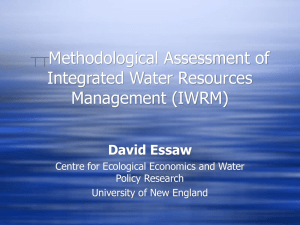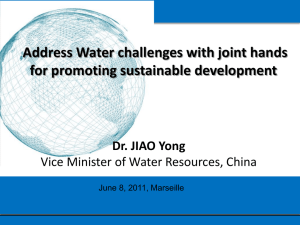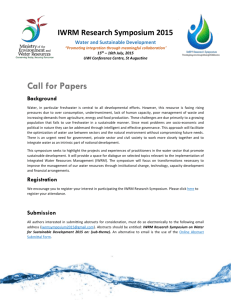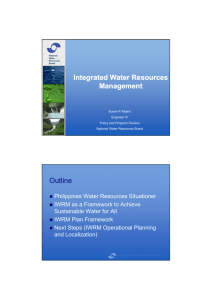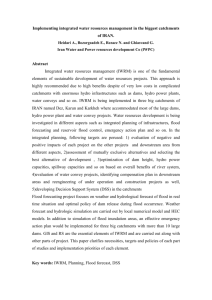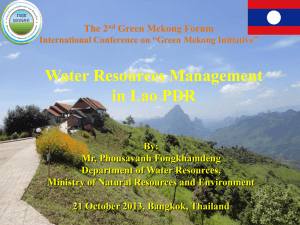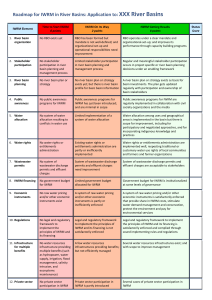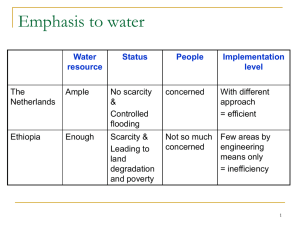Roadmaps for water management in West Africa - UNEP
advertisement
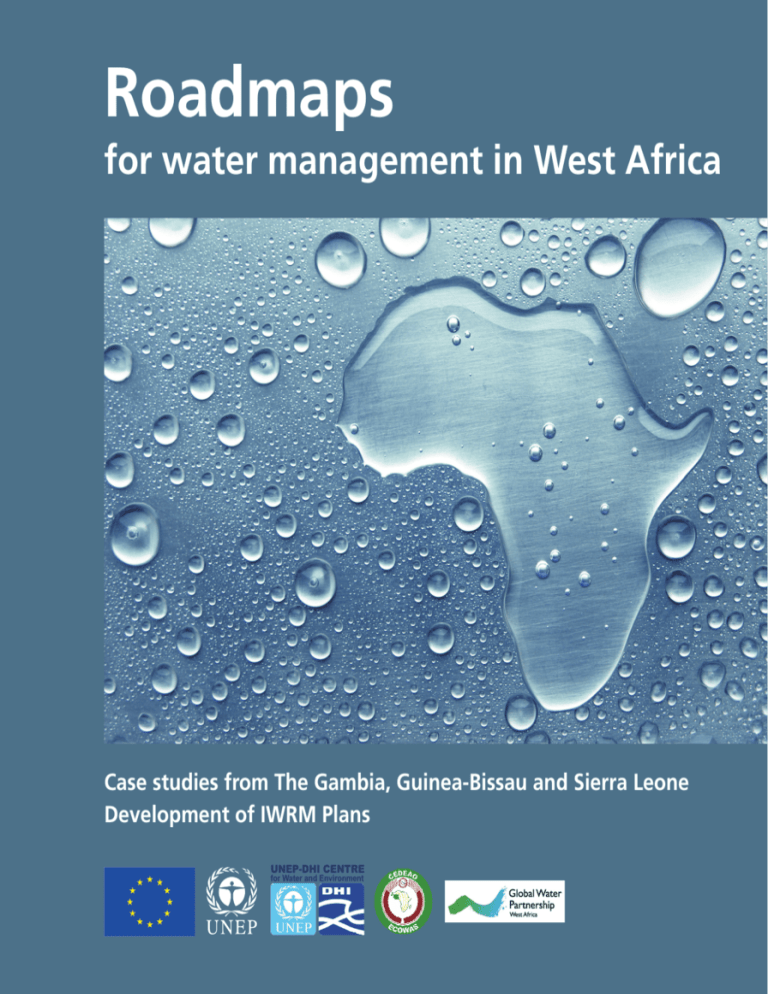
Roadmaps for water management in West Africa Case studies from The Gambia, Guinea-Bissau and Sierra Leone Development of IWRM Plans UNEP-DHI CENTRE for Water and Environment Roadmaps for water management in West Africa Case studies from The Gambia, Guinea Bissau and Sierra Leone Development and implementation of IWRM Plans Contents Background . . . . . . . . . . . . . . . . . . . . . . . . . . . . . . . . .3 Guinea Bissau . . . . . . . . . . . . . . . . . . . . . . . . . . . . . . . .4 Abstract . . . . . . . . . . . . . . . . . . . . . . . . . . . . . . . . . . . . . . .4 Problems . . . . . . . . . . . . . . . . . . . . . . . . . . . . . . . . . . . . . . .4 Context . . . . . . . . . . . . . . . . . . . . . . . . . . . . . . . . . . . . . . . .5 Decisions and actions taken . . . . . . . . . . . . . . . . . . . . . . . .7 Outcomes . . . . . . . . . . . . . . . . . . . . . . . . . . . . . . . . . . . . . .8 Lessons learnt . . . . . . . . . . . . . . . . . . . . . . . . . . . . . . . . . . .8 Relevance of the case to IWRM . . . . . . . . . . . . . . . . . . . . . .8 The Gambia . . . . . . . . . . . . . . . . . . . . . . . . . . . . . . . . .9 Abstract . . . . . . . . . . . . . . . . . . . . . . . . . . . . . . . . . . . . . . .9 Problems . . . . . . . . . . . . . . . . . . . . . . . . . . . . . . . . . . . . . .10 Context . . . . . . . . . . . . . . . . . . . . . . . . . . . . . . . . . . . . . . .11 Decisions and actions taken . . . . . . . . . . . . . . . . . . . . . . .13 Outcomes . . . . . . . . . . . . . . . . . . . . . . . . . . . . . . . . . . . . .13 Lessons learnt . . . . . . . . . . . . . . . . . . . . . . . . . . . . . . . . . .14 Relevance of the case to IWRM . . . . . . . . . . . . . . . . . . . . .15 Sierra Leone . . . . . . . . . . . . . . . . . . . . . . . . . . . . . . . .16 Abstract . . . . . . . . . . . . . . . . . . . . . . . . . . . . . . . . . . . . . .16 Problems . . . . . . . . . . . . . . . . . . . . . . . . . . . . . . . . . . . . . .17 Context . . . . . . . . . . . . . . . . . . . . . . . . . . . . . . . . . . . . . . .19 Decisions and actions taken . . . . . . . . . . . . . . . . . . . . . . .21 Outcomes . . . . . . . . . . . . . . . . . . . . . . . . . . . . . . . . . . . . .22 Lessons learnt . . . . . . . . . . . . . . . . . . . . . . . . . . . . . . . . . .23 Relevance of the case to IWRM . . . . . . . . . . . . . . . . . . . . .23 2 © ISTOCKPHOTO.COM Background The ACP-EU Project, Improving Water Management and Governance in African Countries through support in development and implementation of IWRM Plans, was signed on 14 December 2007 by UNEP and EU. There are four partners in implementing this Action; UNEP, Global Water Partnership (GWP) through GWPWest Africa, Water Resources Coordination Center (WRCC) of The Economic Community Of West African States (ECOWAS) and UNEP-DHI Centre for Water and Environment (UDC), who have formed a project process. The intention is that these cases will assist others in understanding what went on, with a view to recognising some of the most common problems experienced in IWRM planning and developing options for overcoming them. The case studies have been produced in a common format to allow for easy comparison, with the following themes considered: • management group. UDC provides a project team to facilitate and coordinate the implementation of the project as well as make available international technical assistance to the countries. • • The project targets seven countries in West Africa, all in different stages in the Integrated Water Resources Management (IWRM) process. The project has assisted The Gambia, Guinea Bissau, Guinea and Sierra Leone in developing an IWRM roadmap, and has supported the development of IWRM plans in Côte d’Ivoire, Togo and Liberia which have already reached the roadmap stage. • • • The Gambia, Guinea Bissau and Sierra Leone have successfully developed and validated their IWRM roadmap. This is an opportunity to learn from their Problems of water resources management that need to be addressed Context in which the problems and solutions need to take place Decisions and actions taken in order to execute the roadmap process Outcomes of the decisions and actions taken Lessons learnt that will be of value to others involved in similar situation Relevance of the case to IWRM, i.e. how the case exemplifies the problems and solutions associated with IWRM The case studies and road maps are also available on the UDC website, http://www.unepdhi.org/iwrmwestafrica/ 3 Guinea Bissau finalized in 1992 and some IWRM principles were incorporated within them. This Master plan was again updated in 1994 for 10 years and finalized in 1998, but the political crisis prevented its adoption. Abstract Guinea Bissau’s water resources consist of surface water found in the river Geba-Kayenga and the KolibaCorubal and its tributaries, and multiple aquifers found at different depths throughout the country. These two rivers are the only ones providing surface freshwater, therefore their management is challenging for agriculture and domestic use in the country. Pressure on water resources in Guinea Bissau is aggravated by population growth and mismanagement which leads to resource overexploitation quantitative and qualitative degradation, shortages in certain regions, health risks due to pollution, etc. The country has been trying to adopt the IWRM principles since 1992 and has created a platform for the management of water resources which needs to be reactivated. The newly elaborated IWRM roadmap, as well as the water and sanitation master plan, will lead to: 1) awareness raising of problems related to water resources and promotion of the political will to address them, 2) a legal framework oriented towards IWRM, as well as an institutional framework in which management is separated from services, and 3) human capacity building for stakeholders at all levels. Due to the recent unrest in Guinea Bissau, several institutions in the country are having difficulty delivering on their mandate. The Water Resources Management department is no exception. Indeed, in 1988 Guinea Bissau initiated the elaboration of a Water and Sanitation Master Plan and the Water Act (financed by UNDP). These legal and political instruments were The major constraints towards IWRM are lack of proper means (financial and material) and the socio-political situation which does not facilitate fundraising. This leads to: 1) limited funds; 2) an inability to monitor and evaluate the resources; 3) insufficient human resources to deal with institutional and legal matters, resolve conflicts and address problems of overlapping jurisdiction; 4) and a lack of storage and distribution facilities. © FERDERICB | DREAMSTIME.COM Problems 4 Water resources in Guinea Bissau are subject to a several natural and human pressures including: 1) climate change and variability, 2) abstraction, 3) wastewater disposal, and 4) urbanization. In the absence of adequate management responses, some of these pressures could even pose a threat to long-term water security. Major threats to surface and groundwater resources, defined by their magnitude, persistence, and social impacts are identified as: i) depletion of water stock and, ii) pollution of water resources. © SUE ROBINSON | DREAMSTIME.COM Single and multiple risks posed by these threats can be summarized as creating scarcity through reduced water resources availability and suitability for multiple purposes, leading to increased development, treatment and delivery costs of water. is chaired by the Head of State with the participation of public, private sector and civil society in determining the country’s water policy orientation. However, these institutions are not functioning and sectoral water resources management still prevails in Guinea Bissau. Depletion of surface water resources is not currently as significant a problem as quality degradation. However, water abstractions for rice irrigation, and, increasingly, mangrove deforestation for crop plantations could lead to erosion and saline intrusion. Context Guinea Bissau is located in the tropical humid region of West Africa. The country is situated at the border of Atlantic Ocean and is limited in the North by Senegal, in the East and South by Guinea. It covers an area of 36.125 km2. Guinea Bissau is composed of two parts: a continental area and offshore islands. The continental area consists of coastal floodplains and relatively flat inland terrain in the region of Bafata and Gabu, with an area of small hills of about 300 m near Boé. The island part is constituted by the Bijagos archipel composed with 50 islands among which only 20 are occupied. The most important are Bubaque, Bolama and Maio. Several governmental and local institutions are involved in the management of water resources in Guinea Bissau. A platform for large stakeholder participation does exist but its functioning needs to be strengthened. Indeed, since 1992, a Water National Council (CNA), an Inter-ministerial Council for Water (CIMA) as well as a Technical Committee for Water (CTA) have been created with the purpose of harmonizing the use and management of water resources. The can, for example, 5 © OLIRA | DREAMSTIME.COM Physical data Area (km2) 36,125 Total internal renewable water resources (IRWR) per capita (m3/year) 31 Total water withdrawal per capita (m3/year) 120 Water use by sector (Agr/Ind/Dom) (%) 29/1/70 Socio-economic data Population (mill) (2004) 1.5 GDP (USD per capita) (2008) 600 Urban population (% of total) 12 GDP composition by sector (Agr/Ind/Ser) (%) 56/10/24 Labour force by occupation (Agr/Ind/Ser) (%) 62/12/26 6 Decisions and actions taken Good governance also requires that water resources departments have the means, human and material resources, equipment and funds needed to deal with the constraints and challenges they face, and plan better water management. Good water governance requires good quantitative and qualitative knowledge of the resource as well as its permanent monitoring and evaluation, especially regarding the impact of human actions on water resources. Such knowledge is a pre-requisite for an IWRM and serves to prevent incidents such as pollution, inundation or saline intrusion. The table below summarizes the actions identified so far. Date Milestones December 2008 Identification of water resources problems January 2009 Ranking of water resources problems and elaboration of a format for the IWRM roadmap End of April 2009 Elaboration of the IWRM roadmap May 2009 Validation of the IWRM roadmap June 2009 Updating of the Water and Sanitation Master Plan using IWRM principles Updating of the enforcement law of the water act Updating of the enforcement law Environmental act In 2009 Initiation of elaboration of the IWRM action plan building on the existence and producing necessary synergy with the MDGs In 2009 Lobbying, information, training and communication on IWRM aimed at water actors and the population as a whole In 2009 Revision of the water act and finalization of the implementation decrees as well as those for environment In 2009 Approbation of National Water Funds and its rules and regulations, Reactivation of CNA, CIMA and CTA Creation of a Country Water Partnership In 2009 Setting up of a sustainable monitoring and evaluation system for water resources planning and prediction of water demand In 2009 Setting up an information system on water resources supported by a data base (GIS) In 2009 Elaboration of fundraising strategies for investment and management of water resources In 2009 Creation, monitoring and periodical control of a primary network for water resources, included groundwater quality (control of saline intrusion in areas with high potentiality) Mid-2011 Elaboration and adoption of an IWRM action plan for Guinea Bissau. Elaboration of a training action plan elaborated. Representation of key institutions in water sector and institutionalization of a Stakeholder working group by ministerial decree. End-2011 Elaboration of a project portfolio from the IWRM action plan and its presentation at a donors roundtable. Mid-2012 Funding of the IWRM action plan (100% of priority actions and at least 75 % of the whole) End-2012-2015 Implementation of the IWRM action plan in Guinea Bissau 2012 Review at global level of progress made towards IWRM 2015 Evaluation at global level of IWRM contribution to meeting the MDGs 7 Outcomes The concrete outcomes of the Guinea Bissau IWRM roadmap process, which covers the period 2009-2015, comprise: • • • • • Situation analysis with a focus on challenges, constraints and opportunities faced by the country on water resources National dialogue and awareness raising on IWRM with participation of many different stakeholders (three regional workshops and one national dialogue were conducted) Completion of the IWRM national roadmap1 Needs assessment and further actions to implement the IWRM reforms as identified in the national roadmap and necessary synergy with ongoing projects such as elaboration of the Master Plan for water and sanitation • An effective co-ordination mechanism is important for IWRM. A key issue is the creation of effective coordination mechanisms between different agencies in order to increase co-operation and co-ordination, which in turn leads to less fragmented management responsibilities and improved effectiveness of water resources management. In many cases an apex body at the national level may be desirable for Lessons learnt from the IWRM 2009 case of Guinea Bissau include: • • 1 encouraging and much work was done by local staff. This facilitated a strong ownership to the outcomes at national level. By seeking synergy with ongoing process such as the one on the elaboration of the Master Plan for water and sanitation, an opportunity to start implementing identified actions on the roadmap was established and sustained. Relevance of the case to IWRM Lessons learnt • ministries, the private sector and civil society enhances the involvement of a wide number of stakeholders. Consequently, it is possible to reduce the input of both national and international consultants (and their “fingerprints” in the outcomes) to an absolute minimum. The commitment and engagement of the government, particularly in the DGRH was most The inertia of the process is sometimes difficult to overcome, but once the momentum has built up it is difficult to stop it and the process itself becomes a self-fuelling engine. At present, the representatives of the different stakeholders are all motivated and want to participate in elaboration of the IWRM action plan. It is the responsibility of the Government to keep the momentum flowing. By placing the responsibility for the drafting of the IWRM roadmap directly with the Directory General of Water Resources (DGRH), the political and administrative impact of the outcome is maximised. The establishment of a stakeholder group which comprises representatives from various departments, the accomplishment of IWRM. It should at least be responsible for developing policies and strategies, and for co-ordination and national planning regarding water resources. By placing the responsibility for the drafting of the IWRM roadmap directly with the national apex body in Guinea Bissau, the political and administrative impact of the outcome was maximised, while manning the drafting task force with multi-departmental representatives created an opportunity to establish mutual acquaintance and contacts between ministries and departments. The roadmap is validated and available (May 2009). 8 © SUE ROBINSON | DREAMSTIME.COM The Gambia Although the first legislation dealing with water resources dates back almost a century, the first water specific legislation, the National Water Resources Council Act (1979) is relatively recent. Surprisingly, however, the Act has been relatively insensitive to changing national and global circumstances commencing in the early 1980s. Stasis of the Act coupled with compartmental development of legislation draws attention to the role of the legislative branch of government, that is, the National Assembly of The Gambia, in monitoring policy implementation and water governance, including conflict resolution. Major threats to surface and groundwater resources, defined by their magnitude, persistence, and social impacts are identified as: i) depletion of water stock, and ii) pollution of water resources. Abstract The Gambia’s water resources endowments consist of surface water found in the river Gambia and its tributaries, a few coastal streams, and multiple aquifers found at different depths throughout the country. The main surface water body, the river Gambia, is a highly seasonal transboundary river subject to marine influences during two months or longer in the year, for more than half its length. Water in the river is perennially saline in the last 100 km before it meets the Atlantic Ocean. Sparse data on flash flows in coastal catchments point to their insignificance relative to alternative sources of freshwater. Deep aquifers are connected to regional flow systems and/or leakage from overlying aquifers. Current best estimates of storage, already two decades-old, are 0.1 and 80 km3 for the phreatic and deep sandstone aquifers respectively. Integrated Water Resources Management (IWRM) per se is still in its embryonic stage of development in The 9 © FERDINANDREUS | DREAMSTIME.COM Gambia. Water management is sectoral and biased towards service delivery. The most significant progress registered is creating awareness of the IWRM process in a cluster of key institutions. This roadmap constitutes a blueprint for action that moves The Gambia closer to its IWRM vision, starting with immediate improvements to the current situation. The national process is convergent with the Economic Community of West African States (ECOWAS) Regional Water Policy and Water Vision. A fair amount of work is needed however to align river basin organization and national approaches to water resources management. Strengths to build on include: the participation of business entities in water resources development and management activities, establishment and consolidation of the Public Utilities Regulatory Authority (PURA) and technical capacity of government’s water quality laboratory, run by the Department of Water Resources DWR). Spatial and temporal distribution of water resources and specific geological contexts constitute natural constraints to water resources development in some parts of the country. Low human capacity best exemplify institutional constraints whose impacts are profoundly felt during development, review and refinement of management instruments. Inadequate sector financing is another major handicap. In effect, DWR’s capacity to carry out its statutory responsibilities is compromised by its inability to collect, analyse and disseminate baseline planning information. Opportunities to explore that could have significant payoff for IWRM practice include recent institutional reforms, and potential donors’ positive reception of current activities and direction of IWRM. 10 Problems specified for developments involving obstruction of flows3. Sensitization of developers or enforcement of regulations in member countries appear to be low-key or totally absent4. Major threats to surface and groundwater resources, defined by their magnitude, persistence, and social impacts are identified as: i) depletion of water stock and, ii) pollution of water resources. Single and multiple risks posed by these threats can be summarized as creating scarcity through reduced water resources To start with, sectoral policies do not pay sufficient attention to interactions with water resources. This has led to a disjointed management framework with inadequate definition of institutional roles and responsibilities (overlaps and gaps), and little concern for negative externalities arising from sectoral policies. Furthermore, stakeholder participation is limited and ad hoc in nature. The absence of management tools and credible databases epitomise major water resources planning and management constraints. Low human capital within lead agencies is another good indicator of institutional constraints. Its impacts within the water sector appear at different levels including development, review, and refinement of management instruments. Administrative inertia linked to human capital deficits commands special attention because timing is often crucial to the appropriateness of responses. availability and suitability for multiple purposes, leading to increased development, treatment and delivery costs of water. Indeed, water resources are subject to a several natural and human pressures including: 1) climate change and variability, 2) abstraction, 3) wastewater disposal, and 4) urbanization. In the absence of adequate management responses, some of these pressures could even pose a threat to long-term water security. Depletion of surface water resources is not currently as significant a problem compared to quality degradation. However, water abstractions for rice irrigation, and, increasingly, plantation crops in the Upper River Region (URR) could alter the dynamics of saline intrusion in the River Gambia. Risks of groundwater depletion owe a lot to increasing demand associated with population growth, but is equally amplified by urbanization, the latter having the double effect of concentrating demand and reducing groundwater recharge2. Context The smallest country in mainland Africa, The Gambia occupies a land area of 10,690 km². Except for a small fraction of territory on its Atlantic seaboard, The Gambia is perfectly nested within the Gambia River Basin, shared with the republics of Guinea, Guinea-Bissau and Senegal (Figure 1). Almost 50% of the country’s land area is 20 metres or less above sea level and just 3.8% in the hinterland is above 50 metres. Under some unwritten code similar in effect to the prior appropriation doctrine, riparian landowners in cross-border sub-catchments take no heed of nuisances caused or perpetuated by developments on their land. It appears that no consent is required or exemptions 2 The effect of surface sealing may be offset to some degree by occult recharge from on-site sanitation systems (Njie, 2002).Njie, M., 2002. Second Assessment of Climate Change induced vulnerability in the Gambian Water Resources Sector and Adaptation Strategies. Consultancy Report for National cleat Committee (The Gambia), Banjul. 71p 3 Developers are not required to prepare an environmental statement (ES), and environmental assessment (EA) process by decision-maker/consenting authority not disseminated or rigorously followed. Dams have been reportedly built by Senegalese villagers along a tributary of the Gambia River at Anambé and/or Kabadine Lamoye, and on the Bintang Bolon, without consulting downstream users, OMVG or Gambian authorities. 4 The OMVG Permanent water Commission (PWC) is empowered to monitor situation on the ground, and can call upon the Hydrological Studies Steering Committee (HSSC) to provide hydrological information relevant to its work. 11 © OLIRA | DREAMSTIME.COM Physical data Area (km2) 10,690 Total internal renewable water resources (IRWR) per capita (km3/year) 22 Total water withdrawal per capita (km3/year) 0.02 Water use by sector (Agr/Ind/Dom) (%) 91/2/7 Socio-economic data Population (mill) (2003) 1.36 GDP (USD per capita) (2007) 1,300 Urban population (% of total) (2008) 54 GDP composition by sector (Agr/Ind/Ser) (%) 233/8/9 Labour force by occupation (Agr/Ind/Ser) (%) 75/19/6 12 Decisions and actions taken Outcomes A set of 13 priority actions, deemed necessary to make the transition from current unsatisfactory management practices to full-fledged IWRM, constitute the Gambia’s IWRM roadmap. The actions are grouped under five themes: 1) facilitation of the reform process, 2) stakeholder engagement, 3) rejuvenation of an enabling environment, 4) capacity building and, 5) action plans and project development. Subject to timely external inputs, specific actions start as early as July 2009 and last through 2015. Figure 2 below illustrate the process which led to these actions. The concrete outcomes of The Gambia IWRM roadmap process comprise: • • • Situation analysis with focus on challenges, constraints and opportunities faced by the country on water resources of The Gambia in 2007 National dialogue and awareness raising on IWRM with participation of many different stakeholders (3 regional workshops and one national dialogue were conducted) The establishment of the IWRM task force 2008 �������� ����������� ����� ����� �������� ��������������� ������ ����� � ��������� ����� �������� ������������ ���������� ����� ������������� ��������� ����������� ����� ������ ��������� ��������� �������� ����� ������������ ��������� ������ ����� �������� ������� ������ ����� ����������� ��������� ������ ����� ������������ ���� ����������� �������� �������������� The Gambia IWRM Process illustrating the different phases (on time axis) the country has come through and key events during these phases. The process stalled somewhat between 2007 and 2008, but has picked up a steady pace and made good progress since June 2008. 13 Date Milestones Mid-July 2009 Commissioning of the IWRM Task Force and Oversight Body End of July 2009 Conveing of the first working/planning meeting of the IWRM Task Force End of October 2009 Finalization of the fourth quarter work plan, and ToRs for preparing a communication strategy End of April 2010 Finalization of the communication strategy finalised End of August 2010 Adoption of the Country Water Partnership (CWP) Constitution End of December 2010 Completion of countrywide consultations End of July 2011 Implementation of the resource mobilization strategy; final revision of water policy and strategy; and finalisation of the project portfolio and investment programme End of February 2012 Endorsement of the IWRM Action Plan by government End of April 2012 Enactment of updated primary water legislation and repeal of NWRC Act 1979. Decommissioning of the IWRM Task Force and oversight body (with newly established statutory bodies taking over the functions and responsibilities of the now defunct Task Force and its oversight body) End of June 2012 Ending the mobilization of resources for roadmap implementation End of December 2012 Review of roadmap implementation progress End of December 2013 Review of implementation progress End of December 2015 Evaluation of Gambia IWRM Action Plan and draft of new roadmap completed • The elaboration of the Water Resources Policy framework 2007 which has been adopted by the Cabinet in 2007; • Completion of the IWRM national roadmap • Water sector reform study for the country which an integrated part of the IWRM process. The roadmap covers the period 2009-2015 and a summary table below spotlighting key milestones, landmark events and indicators gives a good idea what the roadmap is about. Lessons learnt The Department of State with policy responsibility for water resources has shown enthusiastic buy-in to the IWRM roadmap process and a willingness to embark on institutional reform. This has been underpinned by closure between policy/legal/management instruments, which could be seen as signs of strong political will to bring water management into line with international best practice. 14 • • • • • It is of great importance to look for inspiration from other cases of implementation of IWRM plans in general and, particularly, in the region. The case of Burkina Faso and Côte d’Ivoire is a relevant reference for The Gambia process and future steps to be followed. The establishment of a stakeholder group which comprises representatives from various departments, ministries, the private sector and civil society enhances the involvement of a wide number of stakeholders. Consequently, it was possible to reduce the input of both national and international consultants (and their fingerprints on the outcomes) to an absolute minimum. It is tempting to have high-level national experts write the roadmap. However, while this may produce a document of high quality, it lessens the sense of ownership by the government team. It is therefore preferable to strengthen a staff from the water resource department to lead the process and deliver the product. The water sector reform was seen as a pre-requisite in the IWRM roadmap elaboration process. It is thus important to have flexibility to take into account the needs and request from the country while drafting the roadmap. Participatory processes take much longer than nonparticipatory ones. This must be taken into account when the roadmap process is designed. This kind of participatory process also provides a place for all other stakeholders (besides governmental) to bring to the table their concerns and ideas about water planning, which may otherwise ignored. © SUE ROBINSON | DREAMSTIME.COM Among the lessons learnt from the IWRM roadmap elaboration in The Gambia are the following: certain basic principles underlying water resources management, and IWRM in particular, may be commonly applicable, independent of context and stage of economic development, there is no universal blueprint as to how the definition and the IWRM principles can be applied, especially in The Gambia with a small population of 1.3 million. The Government of The Gambia upholds the view that sustainable water resources management must feature high on the country’s development agenda. The current reform process is therefore to provide institutions and entities entrusted with the custodianship of water management with the renewed legal authority and the technical and administrative instruments they need to manage the resource in an equitable way. As part of the IWRM roadmap, therefore, the water sector reform process addresses issues which are at the heart of the challenges that confront water resource management in The Gambia. It will also provide a platform for The Gambia’s development partners to redirect their technical and financial support portfolio to water sector reforms. Relevance of the case to IWRM The Gambia IWRM roadmap defines water resources management as the set of policies and practices around the use of water resources to attain desired goals. However, it must be pointed out that whereas 15 © KELLY FAJACK / STILL PICTURES Sierra Leone Abstract Sierra Leone is well endowed with inland waters (rivers, lakes and flood plains) which support a large variety of aquatic life. Sierra Leone is indeed, well drained by numerous rivers and creeks. The main rivers in the country have their sources in neighbouring countries Guinea and Liberia. As a result of ten years of civil unrest in the country, very important water resources information formerly held at the Water Supply Division were destroyed. Thus, one must routinely contend with insufficient and often unreliable data, particularly data on water resources. There is virtually no one to establish baseline conditions for water resources planning and management. Many hydrologic and meteorological monitoring stations and networks are not operational. Even information on the location of systems components, e.g., pipes and valves in a distribution system, are often missing or inaccurate. Sierra Leone has no unified legal regime governing water resources management. The legislation applying to the capital city, Freetown, in the Western Area is based on the British Common law system according to which water resources, except large streams and underground water flowing in well known and defined channels, vest in the ownership of the riparian landowners. In the rest of the country outside the Western Area, (Provinces), water has remained, together with land, the common resource of riparian communities. The Water (Control and Supply) Act, 16 1963, however, provides for all water resources within declared water supply areas to vest in the ownership of the Government, a concept known as State Ownership. Thus, the legal regime of water use rights depends on whether water rights derive from private land ownership, community trusteeship or statutory title. In the latter case, the legislation of Sierra Leone currently knows of no less than ten such licenses, permits, leases, grants or concessions, each one falling under the control of a different authority. Water resources management in Sierra Leone is carried out on a sectoral basis, under which each institution involved in water related issues has its own separate legislation on management of the resource. © EDGAR CLEIJNE / STILL PICTURES The present water sector legislation in the country, though out-dated, provides for water resources conservation, development and utilization to be centrally controlled under the aegis of Government. Thus, government has traditionally and by law had a central role in the provision of water and in planning and directing the water sector. With the decentralization of governance structure and the devolution of certain responsibilities to local government, the central government will of course continue to play an important role in the sector. Sierra Leone plans to undertake water resources development programs which are concerned mainly with facilitating single purpose water uses; water supply (rural, peri-urban, urban, industrial, etc.); hydro power (Dodo /Goma Dam, Bumbuna Dam, etc); irrigation (in-land valley swamps, purpose Rhombe and Rolako swamps, etc); with much less emphasis placed on the institutional issues of controlling and co-ordinating water uses and users with out-dated legislation in the sector. These isolated water resource development programs considered to be supply-oriented have resulted in several problems. Some of these are manifested in several ways such as: In consideration of a sustainable utilization of the resource (water) and minimization of its associated problems, a transition has been deemed necessary to be made from the sectoral development and management of the resource to one in which the different uses of water are considered together holistically. Problems After ten years of civil unrest in the country, Sierra Leone is now facing a major challenge in reconstructing the country and the sustainable management of the nation’s water resources constitutes a key factor in the efforts to improve the socio-economic condition of the citizens. • 17 Lack of a Central Institutional Framework for IWRM: Water Resources management in Sierra Leone tends to be highly fragmented in the country at the moment, with responsibilities for planning, development, and management typically dispersed among a multitude of Ministries, Departments, Agencies (MDAs). These sectoral divisions have further been reinforced by projects and sector specific lending practices of external donors like the World Bank, the African Development Bank, Food and Agriculture Organization, Islamic Development resources. The inefficient use of water resources is reflected in various ways, but two manifestations are the virtual non-existence of multi-purpose water projects and the lack of surface and ground water conjunctive use projects. Irrigation, water supply, hydro-electric projects are typically planned and constructed with the single purpose in mind with very little consideration for other uses. Also, the Bank, etc. There is no formal mechanism existing for disseminating information generated as a result of isolated interventions across the sector or promoting cooperation and coordination. Another major consequence of the inadequate coordination among administrative entities has been the lack of an integrated approach to water resources management and inefficient use of water hydrologic connection between surface and ground water is often poorly reflected in technical and planning studies, laws, and water use regulations. There are towns that rely on both surface and ground water sources, but typically the uses are not coordinated. Inadequate and poorly maintained infrastructure: Previously existing infrastructure – including that © KELLY FAJACK / STILL PICTURES • 18 damaged by the war – including those damaged during civil unrest – has not been maintained or rehabilitated, partly because of limited financial resources, low priority (new projects considered more desirable than rehabilitation and maintenance of existing systems), and a lack of skilled personnel; thus much of the infrastructure, from hydrological networks, to water supply schemes, to irrigation • • • systems, are in poor condition. In general, wastewater treatment facilities are nonexistent in the country as the major urban centres discharge waste water directly into the receiving waters. With the exception again of the capital which has some form of drainage, storm water is typically channelled to the natural drainage system. The systems generally are in a state of ill-repair, often clog, and commonly have insufficient capacity to handle the quantity of flow generated by torrential rain storms. Exacerbating the problem of urban flooding are the poor environmental planning practice culminating in construction of houses on hill tops; the expanding urban populations that are encroaching on the floodplain areas, paving them and reducing their natural carrying capacity. Responsibility for maintaining urbane drainage systems generally falls to the Sierra Leone Roads Authority. But, as noted above, low priority and lack of funds prevent them from performing their tasks adequately. Other technical constraints: As the responsibility for data collection is usually divided among numerous MDAs these are typically collected along sectoral lines and is poorly disseminated. Even when data is available in some cases, its value is limited since it is purpose specific. Information on groundwater resources is virtually non-existing and the resource is not even monitored though the rural communities and majority of the urban dwellers rely exclusively on groundwater, there appears to be very little info about the quantity and quality of the ground water resources. Inadequate enforcement of legislation: In Sierra Leone, the legislation for the administration and management of water resources includes provisions which are no longer relevant and actually may serve to constrain new management initiatives. A more significant concern is the lack of rules and regulation for monitoring and enforcing existing legislation. Human resource capacity: There are human resource constraints for IWRM right across the sector from the national level to local communities. Besides, the few available qualified personnel are biased towards water supply activities while serious shortages remain in the other sector areas. In summary, the main constraint in the sector has been recognized by many as a weak policy framework and regulatory structure, which has resulted in fragmentation of responsibilities and attendant operational deficiencies nationwide. Context Sierra Leone is a member of the Economic Community of West African States (ECOWAS). It is bordered to its west and south-west by the North Atlantic Ocean, to the north and north-east by the Republic of Guinea, and to the east and south-east by the Republic of Liberia. The land area of Sierra Leone is approximately 72,000 km2 and has a coastline of approximately 340 km on the Atlantic Ocean. Freetown is the capital city of Sierra Leone and it is located on the west coast along a peninsular. Sierra Leone has a tropical humid climate with two predominantly distinct seasons, referred to as the wet season which starts from May-October and the dry season that starts from November to April, each of which lasts for about six months. The average annual rainfall varies from about 2500mm in the drier areas of the north-west and north-east of the country to about 3000mm in the southeast and about 5000mm in the Freetown Peninsula. Rivers overflow their banks during the rainy season, and later reduce in the dry season from November to March. The heavy rains and maritime influence leads to high humidity. 19 © OLIRA | DREAMSTIME.COM Physical data Area (km2) 72,000 Total internal renewable water resources (IRWR) per capita (km3/year) 160 Total water withdrawal per capita (m /year) 98 Water use for irrigation (million/m3/year) 370 3 Water use by sector (Agr/Ind/Dom) (%) Socio-economic data Population (mill) (2004) 4,96 GDP (USD per capita) (2008) 700 Urban population (% of total)(2008) 36 GDP composition by sector (Agr/Ind/Ser) (%) 47.2/24.5/22.6 Labour force by occupation (Agr/Ind/Ser) (%) NA 20 Decisions and actions taken Based on status of the IWRM processes in Sierra Leone, the following activities need to be undertaken: 1. Awareness raising on IWRM • • Development of an advocacy strategy Meetings with various stakeholders – politicians, civil society, donors, etc. • • • Establishment of a national water partnership to support the IWRM process in the country Workshops and seminars for members of the national water partnership Public awareness campaigns 2. Creation of a platform for inter-sectoral co-ordination Draft platform for coordination; © SHARPSHOT/ISTOCKPHOTO.COM • • • Working meetings and round tables; Formal platform for network operation (status, regulations, communication procedures 3. Capacity building • • • • • • • evelopment of information system (database, modeling); • Identification of the IWRM planning stages; Assessment of training requirements; • • Training of trainers in IWRM aspects; Development of the relevant initiatives system for creation of necessary “climate” for the IWRM; Managerial capacity building (equipment, communication means, water metering devices, etc.). • Training courses for various stakeholders • 4. Development of IWRM plan and strategy • • Development of an IWRM policy which would be the basis of a new water legislation Sierra Leone; 21 Creation of the relevant managerial structure with the well-defined tasks and responsibilities; possibly a national water resources board Development of the necessary management tools; Identification of groups subjected to the positive and negative impacts as a result of reforms and selection of the most acceptable mechanisms for their adaptation; Estimation of the necessary budget for realization of the IWRM plans; Approval of the IWRM plan and strategy for the transition period; Establishment of national supervisory (coordination) group. Date Key milestone 2009 Awareness raising on IWRM 2009 Establishment of a National Water Partnership 2009 Establishment of a National Water Board 2009 Establishment of a Water Regulatory Institution 2009 Legislation of a new national Water Code (law) for Sierra Leone 2009-2015 Rehabilitation of the national system for hydro-meteorological and hydrological monitoring of water resources 2009-2015 Setting up of a network for monitoring of surface and underground waters and ecosystems 2009-2015 Capacity building 2009-2010 Development, co-ordination and approval of a national IWRM Action Plan for Sierra Leone In each of the above cases, technical assistance would be required. In light of the above, therefore, the following table provides a draft outline for an IWRM roadmap for Sierra Leone. • • • Outcomes • The following results have been achieved so far: • • Increased awareness on importance of environmental approach and considerations in IWRM, and stakeholders empowered and committed to participate in IWRM processes • 5 22 Situation analysis on water resources in Sierra Leone Elaboration and validation of the IWRM roadmap5 Consultative stakeholder meeting on establishment of a National Country Water partnership conducted Capacity building of key water managers and decision makers on IWRM planning. Empowered institution to spearhead the implementation of IWRM plans Capacity built towards roadmap development for the Sierra Leone The roadmap is validated and available (April 2009). Lessons learnt Lessons learnt from the project “Improving Water Management and Governance in African Countries through Support in Development and Implementation of IWRM Plans” in Sierra Leone are the following: • Sierra Leone is at the very beginning of the reform process towards IWRM. The political will and commitment given at highest level were proven to be essential for the implementation of the project. • • • The developed IWRM questionnaires proved to be very instrumental in assessing the National progress on IWRM, identifying elements for specific programme support, capacity needs assessment and identification of foreseen actions needed for the project implementation. The simple approach proved to be manageable with only limited input from international experts, and the major activities and outputs were achieved in less than two years with relatively minor project costs. © FERDINANDREUS | DREAMSTIME.COM • The roadmaps effectively build on available data and studies performed, and the concrete and informal process managed to engage all main stakeholders including civil society and the private sector. In order to keep momentum in the IWRM reform process started it is important that potential donors are involved in the process. Sierra Leone has invited to donor roundtable meeting to explore possibilities for funding of elements in the IWRM roadmap. A participatory approach is the only means for achieving long-lasting consensus and common agreement. However, for this to occur, stakeholders and officials from water management agencies have to recognise thatthe sustainability of the resource is a common problem. Governments at national, regional and local levels have the responsibility for making participation possible. The roadmap development process managed to foster constructive dialogue between multiple stakeholders and to engage national and international funding agencies. Hence, the process has created substantial stakeholder ownership and a realistic framework for implementation of identified activities. Thus, several substantial benefits have emerged as a result of the roadmap process towards IWRM. Relevance of the case to IWRM The Sierra Leone case clearly demonstrates that the IWRM process can be initiated anywhere in the planning cycle. Despite many years of civil conflict in the country and the resulting impact from such a situation, Sierra Leone is now making progress towards the implementation of IWRM principles. Moreover, the case clearly stresses the importance of political will and commitment is a prerequisite for implementing IWRM. 23 24 UNEP-DHI CENTRE for Water and Environment UNEP-DHI Centre Agern Allé 5 DK 2970 Hørsholm Denmark Tel: +45 4516 9200 Fax: +45 4516 9292 E-mail: udc-water@dhi.dk http://www.unepdhi.org/
